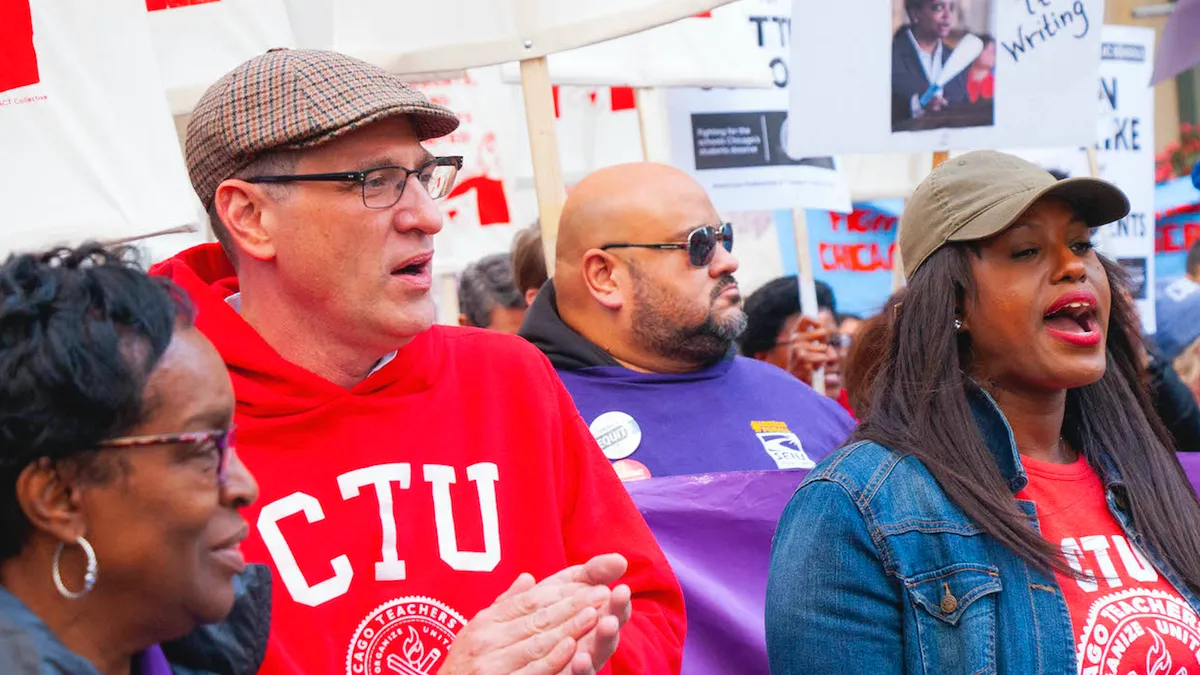This year kicked off with a teacher’s strike in the nation’s second-largest school district, and as the end of 2019 nears, teachers in the third-largest district still haven't reached an agreement with Chicago Mayor Lori Lightfoot and Chicago Public Schools CEO Janice Jackson.
On some levels, the two stoppages are similar. As with United Teachers Los Angeles, the Chicago Teachers Union has a list of demands that focus on issues far beyond pay and benefits, often referred to as “bread-and-butter issues.” These other concerns include class size, support positions such as social workers, counselors and nurses, and even affordable housing for both teachers and families experiencing homelessness.
“This is really the first time we've seen a union push for this demand within contract negotiations,” says Bradley Marianno, an assistant professor of educational policy and leadership at the University of Nevada, Las Vegas. “We've clearly entered a new era of union activism, one that places the strike squarely back in the union's toolbox, and one that extends the scope of union advocacy beyond traditional contract issues.”
UTLA President Alex Caputo-Pearl and others have called it “bargaining for the common good.”
“The current Chicago strike,” Caputo-Pearl says, “is a powerful continuation of this movement, transforming education and the labor movement, fighting for common sense demands like more nurses, counselors and social workers, fighting for those against Republicans and Democrats.”
This “new era,” however, can also extend the length of a strike, which matters for school leaders who are often caught in the middle and are responsible for rebuilding relationships following a stoppage.
Striking under mayoral control
The fact CTU is negotiating with a mayor rather than a school board is likely one reason their demands have expanded to include other government policies.
“While the union might not be able to get affordable housing into the contract, they are negotiating with someone that could do something about it at the city level,” Marianno explains. “Negotiating with an elected official adds an additional layer of politics to the negotiations that you do not see in other districts when you’re negotiating with district personnel. The mayor has made some public promises and statements that the teachers’ strike will test her on.”
Mike Antonucci, who writes about union issues, notes mayors with authority over school districts can also use that governance structure to their advantage when faced with a teachers union’s growing list of demands. Because a city is likely negotiating with other public employee unions, a mayor and city council can “use any settlements they reach as a model for teacher bargaining” — a term known as “pattern bargaining,” he said.
Mayors, Antonucci says, can also “command far more media attention” than district leaders during a strike.
But with Democratic presidential hopefuls vying for the teachers union’s endorsements, the CTU has also become a platform for leading candidates, which draws more attention to the union’s concerns.
Against charters, for charter teachers
The growth of charter schools — usually determined at the state level — is another issue both UTLA and CTU included in their demands, pushing for a moratorium on new charters.
In the Los Angeles Unified School District, Superintendent Austin Beutner repeatedly said the district had no authority over charter growth, but an outcome of the strike was a school board resolution to ask state lawmakers to put a halt on charter growth.
Ultimately, lawmakers passed a compromise that includes some tighter restrictions on charter schools. These include allowing districts to consider the impact a new charter would have on local finances and student achievement, and allowing approvals for charter schools that perform well in the state’s accountability system to go longer before having to be renewed. The law also requires all future teachers in charter schools to have a credential — not just those in core subject areas.
Ironically, at the same time teachers in Los Angeles were protesting against charter school growth, UTLA also came to the defense of unionized charter school teachers who went on strike during the same time. About 80 teachers working for the Accelerated Schools charter network went on strike during the same time UTLA members were out.
The same scenario has happened again in Chicago, with teachers at the Passages charter school out on strike for four days last week. CTU, which represents those teachers, announced a tentative agreement Friday night with the nonprofit agency that runs the charter school.
Open or closed?
Another major difference between both strikes is LAUSD schools remained open throughout the strike. Even though attendance in the almost 500,000-student district dropped as low as 100,000, principals, assistant principals and district office personnel were deployed to lead instruction, often in large common areas with hundreds of students grouped together.
While Chicago schools have continued to provide meals and a “safe place” for students to go, the district has canceled classes throughout the strike — which, in addition to having an impact on learning, has negatively impacted student athletes who have not been allowed to compete while the strike is in progress.
Caputo-Pearl also sees CTU’s current strike as an ongoing campaign connected to two previous stoppages: a seven-day strike in 2012 and a one-day strike in 2016.
“We don’t win the war against decades of under-funding and privatization with just one punch,” he said. “In Chicago, they punched with their educational justice strikes in 2012, 2016 and now in 2019. In L.A, we’re just getting started.”






















